Matty Starr plays to the crowd, enticing them to yell things like “You suck!” and “Give up!” Photo by Sarah Fulton.
Words by Avery Gregurich
It’s Saturday night on the main street in Algona, Iowa, and there are two venues selling tickets.
One’s a movie theater. Across the street, a man is on the sidewalk handing out flyers for tonight’s show held behind him in “The Vault.” The movie theater’s lobby is empty, but it’s standing room only in “The Vault,” where a steel cage match will be the main event.
This is Impact Pro Wrestling. As the house lights dim and the hard rock music and a few DJ lights begin, “The Vault” is no longer merely an industrial space on Algona’s main drag. It’s transformed to a home for both sport and spectacle, for heroes and villains, and a space for fantasy and reality to mesh together for a few hours in the squared-circle.
All of this for a $12 ticket. $15 for a folding chair.
–
The first match of the night features wrestler James Jeffries, 27, (real name: James Jeffries). His entrance music is “Party in the USA.” He looks unmistakably like WWE legend Shawn Michaels, shoulder-length brown hair and headband included. He wears black and white polka-dot pants with pink laces streaming down his legs. He pumps his arms and grins, slapping hands with every kid in the crowd. In wrestling terms, Jeffries is a “babyface,” or good guy.
Like most of the wrestlers of his generation, he grew up during one of the many heights of professional wrestling: the mid-to-late 1990s.
“When I was young, I would watch wrestling with my dad. A lot of the Attitude Era stuff,” Jeffries says. “We both loved wrestling. He watched it when he was young, too.”
True to his in-ring underdog character, he speaks in a quiet voice, revealing his small town Riceville, Iowa roots. He lives in Ames now, because he says he was “ready for the big city.” He’s been wrestling for almost a decade after having trained here at “The Vault” for several months before his first match. “When I was getting out of high school, I was just like, ‘I just want to wrestle once,’” Jeffries says. “Now, I’m going to keep doing it as long as I can.”
He’s got stories that span the spectrum of professional wrestling, from wrestling in front of 10 people outside the Twin Cities during a snowstorm, to getting recognized by a fan in the Des Moines Airport, or signing autographs outside a WWE show in Cedar Rapids. The real-life James Jeffries has worked wherever he could to support the wrestler James Jeffries.
“I was a maintenance man in a factory in Story City, Iowa,” he says. “Before that, I worked as a teacher’s aide for Head Start in Charles City, Iowa.”
There isn’t much money to be made in independent professional wrestling, just as there is little money to be made in minor league baseball or semi-professional hockey. Still, white envelopes are handed out following shows to all of the performers. Jeffries says that Impact Pro Wrestling pays better than most, but, just as with traditional sports, it’s the appeal of something bigger (arenas, crowds, paychecks) combined with a genuine love of the sport that “keeps you coming back and keeps you getting up.”
It’s unclear just where the in-ring character and the man separate, if they do at all.
A few examples: he met his longtime girlfriend, fellow wrestler Frankie Jay, through wrestling; he works for IPW promoter Troy Peterson’s resale business in real life, and when he meets fans at the gas station or the grocery store, it’s not the man pictured on his driver’s license, but rather the man delivering headscissors on the weekends that speaks.
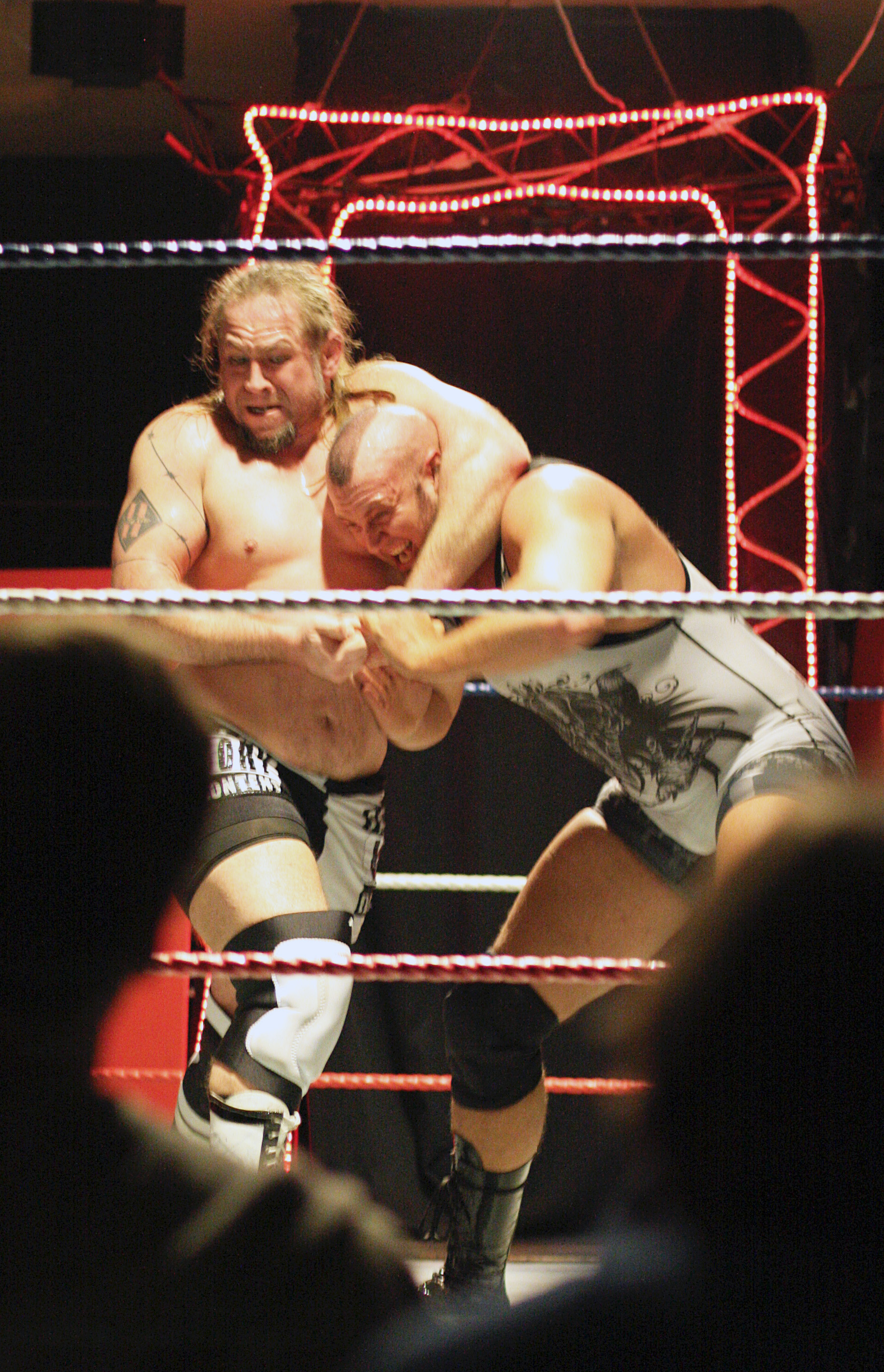
Tonight, Jeffries is slated to lose to the “heel,” or bad guy, Aaron Von Baron. This, and every other occurrence that will happen tonight, is the plan of the man handing out flyers on the street, promoter Troy Peterson.
“To me, it’s just like producing and directing a movie or a play. It’s all written out. You’re writing a script,” Peterson says. “I think pro wrestling is this incredible hybrid form of entertainment that I want as many people as possible to be exposed to.”
As a kid, he says he would fill up notebooks with wrestling tournaments the way that some kids would doodle. He would beg his parents to take him to every show within driving distance, and after drawing straws with other kids’ parents, they would oblige.
“My parents thought I would grow out of it when I was 12. Now, they are taking the tickets for me at 42,” Peterson says, laughing.
Since 2001, Peterson and IPW have been running shows across the state of Iowa and the larger Midwest. From county fairs, to bars, to their permanent performance venues like “The Vault” in Algona and the Baratta’s Forte Center in Des Moines, Peterson has seen his promotion grow steadily over the last 15 years. Still, he feels as though he and other small independent promotions are constantly working against a large preconceived belief about what professional wrestling has been, or what it can be.
“It’s got a really unfair stigma. It has all the disadvantages of the word ‘fake.’ It’s kind of like constantly people considering the world isn’t round,” Peterson says. “It has every disadvantage, also — that it’s bad for kids, that it’s violent, that it’s bloody. It’s a real tough sell, but once you get people there, then they like it. But the same could be said about the opera: It’s tough to get people there.”
–
Halfway through the show, a song by punk band Bad Religion comes tearing through the speakers. Through the curtain walks The Intellectual Punk Tony Sly, (real name: Danny Wagener). He’s around 6’5 and cuts a menacing character standing atop the turnbuckle at the corner of the mat, baring his mouth guard to the crowd. In his horn-rimmed glasses and wearing a silver wallet chain, he resembles something of a jacked up high school math teacher.
He’s been in professional wrestling for 11 years after putting on shows in his college dormitory at the University of Northern Iowa. He attended college on a speech scholarship, and for Sly, professional wrestling has always offered him an outlet to perform. He, too, became enamored with professional wrestling during the Attitude Era, and for most of his career, he’s been a heel. As a heel, it is his sole purpose to elicit boos and jeers from the crowd.
“I think I’m better at it. It’s more natural to me,” Sly says. “You have to kind of channel that bitterness or anger that you have and take the prick-ish qualities that you have and turn that up.”
By day, however, he‘s a father and husband who holds a 9-5 as an investigator for the Iowa Civil Rights Commission. He holds a Master of Public Policy degree from UNI and chooses to golf weekends when he’s not in his wrestling gear. At times, he’s had to draw lines between his in-ring character and his real-life personality and work. He’s held positions as a community organizer in the past, which can sometimes make it difficult for him to do his work as a heel in the ring.
“It’s kind of this double standard. If you are an actor in a play, or movie, or TV show, people can make that distinction,” Sly says. “With pro wrestling, you have to maintain that character to an extent, or you feel that you have to maintain it.”
He’s done whatever he could to, as he puts it, “protect his gimmick,” or push the boundary between fact and fiction. “I’ve had people come up to me in bars after shows and ask me if I was really from Orange County, California. I’ve done some research, so I said, ‘Yeah I grew up in Irvine, between UC Irvine and John Wayne Airport’ and that ‘I moved when I was 11 or 12,’” Sly says. “I’ve lived in Iowa my whole life, but I’ve gotten people to bite on that.”
At 39 years old, Sly is on his way out and eyeing the end of his run in professional wrestling. He says he’s lasted longer than some of his peers because he hasn’t taken every booking or been risky with certain moves in the ring.
“It becomes more of a challenge just to maintain every time the calendar turns,” he admits. “They talk about a bump card: You only have so many bumps in you. I don’t want to be out there when I’m too old or I’ve slowed down too much.”
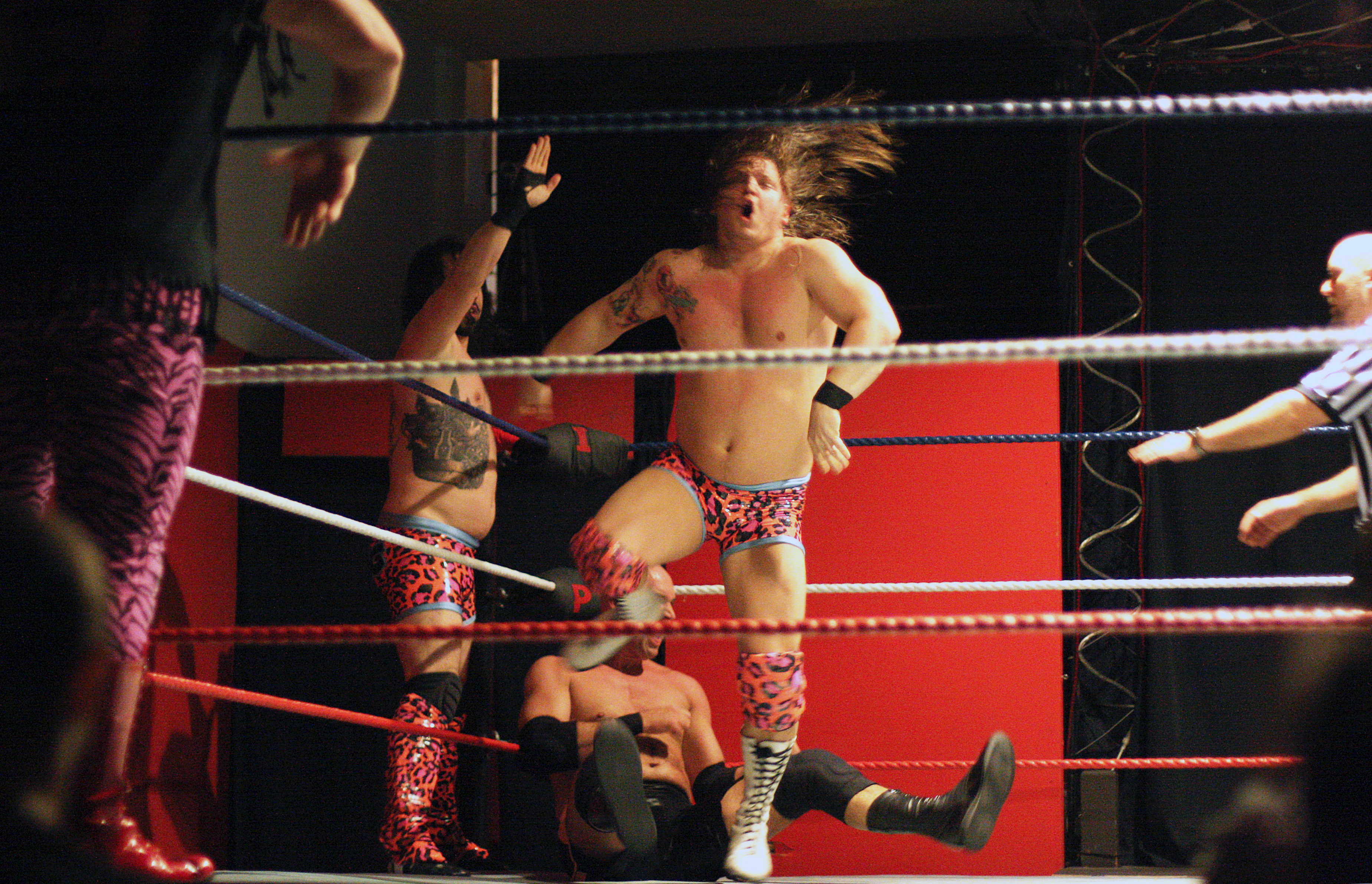
There’s an unusually long intermission tonight. It takes a few men to assemble the steel cage for the first time in IPW history, and it takes a team of men to test its merits after construction. Meanwhile, the crowd eats nachos and watches the men work. A few wrestlers come out to sign autographs for the fans, and they sign posters, pieces of paper, and the kids’ arms. Justin Descent lets one little girl sign his arm.
After the main event, there’s an eight-man free-for-all to claim the Impact Pro Wrestling Vault Championship belt. Von Baron, Sly, and Jefferies are in it, as is one half of the Legend Killers tag team, Matty Starr.
Starr, 30, (real name: Matt Ferguson) wears pink leopard print trunks with “#OMG” written across the seat. Amidst the brawl inside the steel cage, Starr catches an accidental punch from Jeffries, bloodying his nose. He crawls to just in front of the audience, throwing his long hair back out of his face and showing the crowd his actual wound, attempting to further his status as the heel in the match.
It’s what he lives for.
“I like to look at it like The Avengers: Loki was the best bad guy. Mike Myers, Jason, Hans Gruber from Die Hard … it’s no different than the movies,” Starr says. “You wanted to see that guy get his shit kicked in. I asked myself, ‘Why can’t I be that guy?’”
Like his in-ring character, Starr is an excitable man. He’s been wrestling for nearly 12 years, largely for IPW but also for a few other promotions around the Midwest. He’s been hit by chairs, thrown through ladders and landed on beds of thumb tacks, all for the sake of the sport. For him, it began when he was young, when he would sneak across the street to his grandparents’ house to watch pro wrestling on television. In his teenage years, wrestling provided a common language between him and his father.
“We bonded over Super Nintendo and wrestling,” he says.
When he considers why he does this, he counters with his own question.
“Why do a bunch of friends play music in their garage?” he asks. “Because it’s something that they’re passionate about, something that’s fun.”
In real life, Starr works full time at a bar in Des Moines. To him, though, there is no distinction between the weekday man and the character he performs on the weekends.
“They don’t send the rent bills to Matty Starr, but it’s all my real life. I don’t care enough to separate it,” he says. “Twenty-four hours a day I’m Matt Ferguson, but on Saturday for the 5, 10, 15 minutes I’m in the ring, I’m Matty Starr.”
The stories he tells are of wrestling for the first time at the Long Branch Saloon Dance Hall in southern Minnesota, of working with WWE legends Hacksaw Jim Duggan and Goldust. Tonight, sitting in the locker room behind the entrance ramp, he can’t imagine a time when he won’t be in the ring.
“My heart and my brain tell me forever. Right now, I feel good,” he says. “I’ve wrestled in front of five people and I’ve wrestled in front of 3,500 people. I will do this until I physically can’t or until it’s not fun anymore.”
–
After the show is over, and the crowd filters out into the night, the wrestlers gather around in front of the ring. They sip beer and talk about the show, which spots got the best reactions from the crowd, what could have gone better. The younger wrestlers sit on the edge of the circle and fairly hang on every word. Posters of WWE legends and old IPW posters hang on the walls behind them. It’s a fairly mellow scene for folks who pretend fight and throw each other’s bodies into steel cages face first.
Matty Starr’s bloody nose is a popular topic, as are the veterans’ war stories. Tonight was one wrestler’s last performance and so they all take turns taking photographs in the ring.
Eventually, they will have to leave and “The Vault” will go quiet until next month’s show. They will return to their jobs and “real” lives. But for now, somewhere in between the characters they perform and themselves, they are at ease.

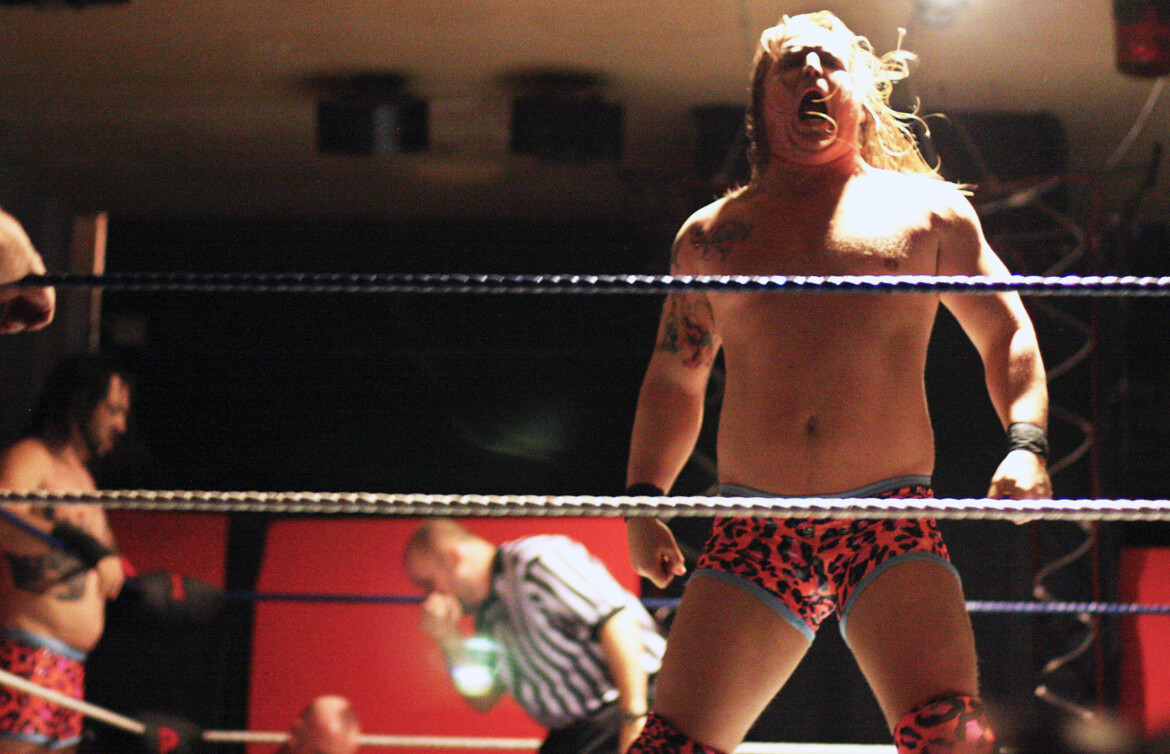
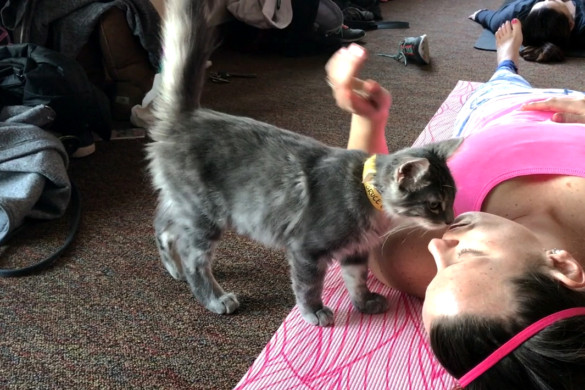


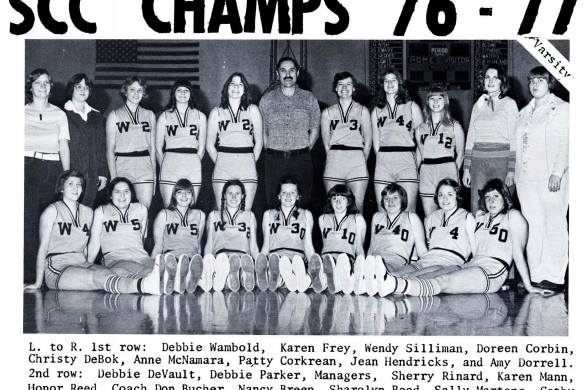
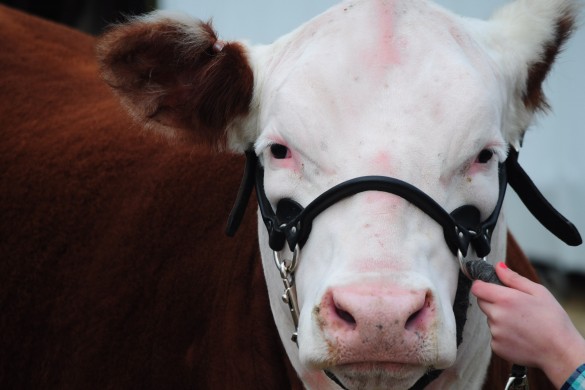

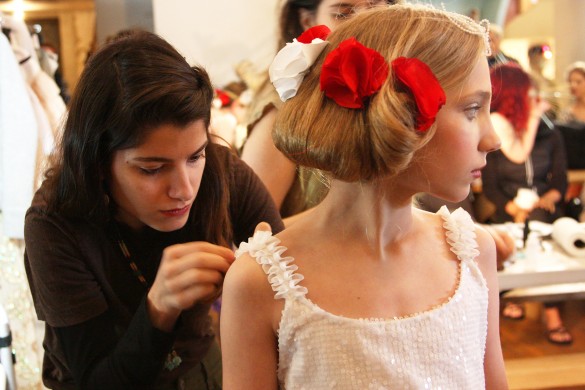


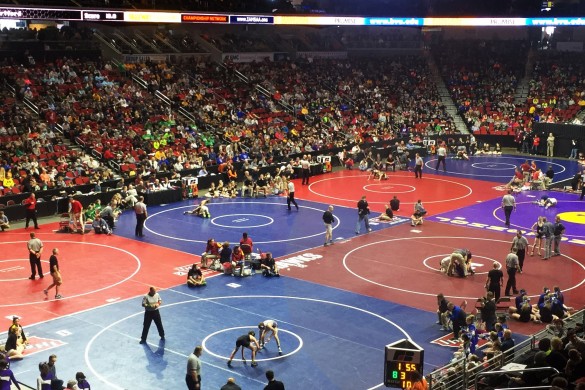
1 Comment
Thank you for an awesome piece of journalism. Honest, informative, and insightful.